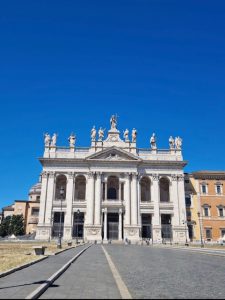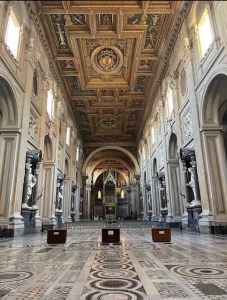It was God’s blessing that I have been to this ancient Basilica. I am astonished at how the whole structure of the church speaks to me of the sacredness and mystical presence of God in the whole edifice of the Basilica of St. John Lateran.
Many Catholics are unaware of the significance of this Feast of the Dedication of the . I believe that a little historical background will be much appreciated. The word “Lateran” reminds us of a noble Roman family whose political power served the entire Roman Empire. The family produced several Roman Emperors that made history during those times. However, the family-controlled political power was defeated by Emperor Constantine in the 4th century when this well-known Lateran palace was occupied under the new Emperor in 311. We all know that Emperor Constantine was a devout Catholic who made “Catholicism” a state religion. Hence, the Lateran Palace was given to the bishop of Rome, and it remains up to the present time. It was after the Council was held there in 313 that it became the center of Christian life in Rome. Lateran Palace was renovated, and Popes began to live there as the seat of the Bishop of Rome and turned it into a Basilica. During the medieval period, it was rededicated to Christ the Savior, St. John the Baptist and now St. John the Evangelist Lateran Basilica, making it the oldest and most important papal church in Rome, aside from the Vatican Square and other existing world-renowned churches in the Eternal City. The Basilica of St. John Lateran is the Cathedral of the Archdiocese of Rome and thus the seat of the Pope as Bishop of Rome.
Let me share with you that the whole structure of any church doesn’t make us a Christian, but it is a sacred place where we have gathered and witnessed sacred celebrations to worship and adore God. It is the house of God and our house where we congregate as a family, which I believe where we worship reveals to us divine realities and supernatural mysteries.
The first reading from the Book of Ezekiel describes the revitalizing water that flows from the temple. Ezekiel’s vision was of a river flowing from the temple in Jerusalem, sharing God’s life which is also a symbol of the Holy Spirit providing the very source of life of the Church, now and forever. I believe that our churches or basilicas are places where we can quench our thirst and hunger for God. St. Paul, in his letter to the Corinthians, uses the representation of a building to describe the structure of the Church when he uttered these words, “But each one must be careful how he builds upon it, for no one can lay a foundation other than the one that is there …”
In the gospel, Jesus was at the temple when He was angered by what He saw. People were making the vicinity of the temple a marketplace and not respecting it as the center of worship and the place where God dwells. I admit that even now, there is the same desecration happening inside the church.
First, many Catholics don’t know how to genuflect in front of the Blessed Sacrament.
Second, during the mass some people walk around, and during consecration some people never give the respect due to God coming down in the form of bread and wine.
Third, try also to check the way we dress and present ourselves pleasing to God.
St. Paul reminds us that we, as individuals, are temples of God. We run the risk of allowing ourselves as temples to be treated with no respect.
May this feast remind us to be renewed as temples of God, and that where we worship, through the Holy Spirit, we will find joy and God’s presence in our church and in every human heart.
God bless you.
Fr. Arlon, osa


